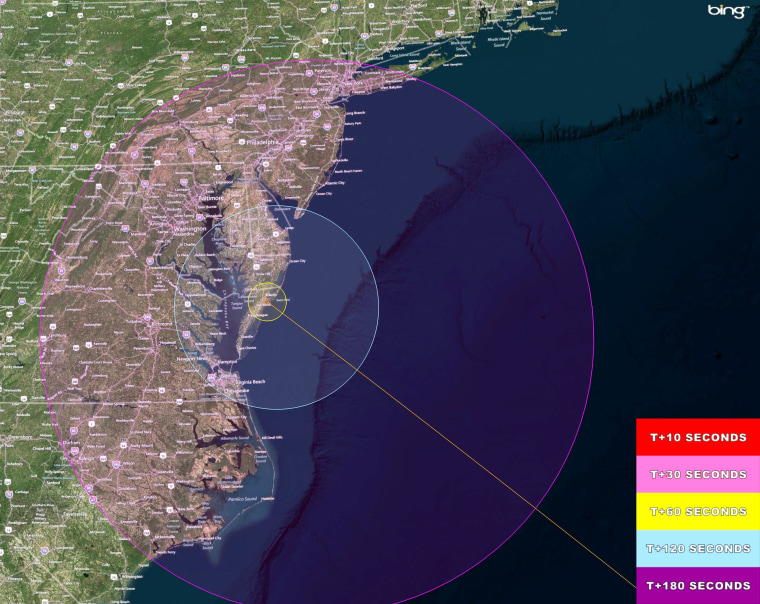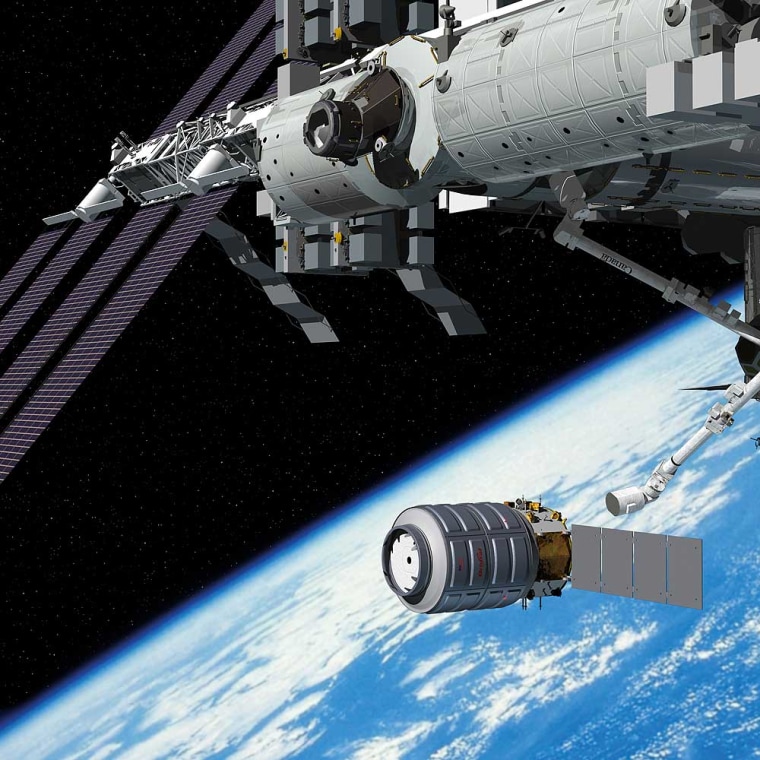Neither glitches, nor storms, nor flying frogs are standing in the way of Wednesday's first launch of Orbital Sciences' Cygnus cargo spaceship to the International Space Station — and East Coasters from New York to the Carolinas may be able to see the rocket arc into the morning sky from its Virginia launch pad.
Well, maybe not the actual rocket.
"Unless you're very close, you will not see a rocket flying through the sky," Sarah Daugherty, test director at NASA's Wallops Flight Facility in Virginia, told reporters Tuesday. "but you'll see a contrail or flames from the stages burning in flight. ... It certainly won't look quite like an aircraft contrail. It'll be much larger, and much lower, and a different shape."
The Cygnus capsule is set for launch atop Orbital's Antares rocket from Pad-0A at Wallops' Mid-Atlantic Regional Spaceport, or MARS, at 10:58 a.m. ET on Wednesday. Daugherty said the weather outlook called for partly cloudy skies, with a 25 percent chance that liftoff would have to be postponed due to low-level clouds.
Cygnus' launch comes less than two weeks after a different type of Orbital Sciences rocket called the Minotaur 5 sent NASA's LADEE spacecraft from MARS to the moon. One of the pictures taken during that liftoff showed a frog silhouetted against the rocket's glare. It quickly went viral on the Internet.
"We'll try to make sure all the frogs are off the launch pad before we take off," NASA spokesman Josh Byerly joked during Tuesday's preview of the Antares-Cygnus resupply mission.

What Cygnus will do
Orbital's objective is to demonstrate that the Cygnus is ready to take on eight space station resupply missions under the terms of a $1.9 billion contract with NASA. This trip represents Orbital Sciences Corp.'s last milestone in a development program supported in part with $288 million in NASA funds.
Virginia-based Orbital was selected in 2008 to join California-based SpaceX as a carrier of cargo for the space station in the wake of the space shuttle fleet's retirement. SpaceX has a separate $1.6 billion resupply contract, and has already sent three of its Dragon cargo capsules to the space station and back.
This week's Antares launch follows up on an earlier orbital demonstration mission in April. For that mission, the two-stage Antares merely launched a dummy capsule that simulated the cylindrical Cygnus' shape and heft. Thus, this mission marks the Cygnus' first honest-to-goodness flight to orbit.
Cygnus is capable of taking 4,400 pounds (2,000 kilograms) of cargo into orbit, and even more when future upgrades are added. This time around, it will be delivering about 1,500 pounds (700 kilograms) of non-essential goods — including chocolate and other goodies for the space station's crew.

The flight plan calls for Cygnus to go through 10 sets of maneuvers over the course of four days, just to prove to NASA that it can be operated safely and reliably. At about 7:25 a.m. ET on Sept. 22, the craft will close in to be captured with the station's robotic arm. Station crew members will then pull it in for its berthing onto the orbital outpost's U.S.-built Harmony module.
After Cygnus' cargo is stowed aboard the station, astronauts will fill the capsule back up with their orbital trash. Unlike SpaceX's Dragon, the Cygnus is not designed to make a return trip to Earth. Instead, the craft will be set loose about 30 days after its arrival, and then guided into a fiery, fatal plunge through the atmosphere over the South Pacific.
Delayed by a glitch
The launch was originally scheduled for Tuesday, but had to be delayed due to poor weather for the Antares' rollout on Friday — plus a communication glitch that cropped up between the rocket's flight computer and the ground control system at Wallops. The problem was traced to a fiber-optic cable that apparently sustained damage during the rollout, said Mike Pinkston, Orbital's Antares program manager. He said "everything worked fine" once the cable was replaced and a power switch was reset.
A communication glitch also forced a delay for the first Antares launch in April, but Pinkston pointed out that the earlier glitch involved a cable that was pulled out from a socket on the rocket. "Completely different issues, same circuit," he said.
Orbital traditionally gives names to its individual spaceships — and Frank Culbertson, a former space station commander who now serves as the company's executive vice president, said the first Cygnus to fly in space would be named after G. David Low, a former NASA astronaut and Orbital executive who passed away in 2008.
Culbertson noted that Low was instrumental in getting Orbital involved in the space station resupply program. "I think he'd be proud of what we've done so far," Culbertson said.
More about the Cygnus debut:
- Cygnus vs. Dragon: How the spaceships measure up
- Spaceship carries necessity of life: Chocolate
- Virginia spaceport doing a booming business
Orbital Sciences' website provides screen shots showing the Antares rocket's expected trajectory as seen from various East Coast locations. If you can't see the Antares launch in person, you can watch it online via NASA TV's website. Live launch coverage begins at 10:15 a.m. ET Wednesday, leading up to the scheduled liftoff at 10:50 a.m. ET.
Alan Boyle is NBCNews.com's science editor. Connect with the Cosmic Log community by "liking" the NBC News Science Facebook page, following @b0yle on Twitter and adding +Alan Boyle to your Google+ circles. To keep up with NBCNews.com's stories about science and space, sign up for the Tech & Science newsletter, delivered to your email in-box every weekday. You can also check out "The Case for Pluto," my book about the controversial dwarf planet and the search for new worlds.
